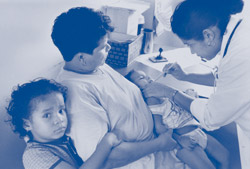|
|
|
Genomics Efforts Target Global Infectious Disease
|
|
 |
|
|
In a Nicaraguan clinic, a doctor checks a baby's throat. Malaria, leprosy, and Denuge fever are among the diseases seen at this clinic.
|
|
|
|
|
|
|
After many decades of retreat, infectious diseases have resurfaced to threaten human health, particularly in the poorer regions of the earth. Malaria, resistant to once-effective antibiotics, is killing more than a million people a year, most of them children. In the developed world, opportunistic pathogens are finding environmental niches by infecting people with immune systems weakened by other conditions.
Genomics may have a major role in controlling the resurgence of infectious diseases. A major national effort centered at the UW uses X-ray crystallography to map the protein structures of four tropical protozoa, or single-cell organisms, each a parasite-borne agent of a deadly and pervasive disease.
Using protein structures as starting points, researchers will synthesize inhibitors and then attempt to refine them with protein engineering techniques into therapeutic drugs. Dr. Wim Hol is the principal investigator on the Structural Genomics of Pathogenic Protozoa (SGPP) project, which includes participants from six research institutions nationwide. He estimates that 30 new drugs could be needed for long-term control of just the protozoan diseases. The immediate goal is to automate and accelerate current methods, which typically study one or two protein structures at a time. Automation would allow scientists to produce results for hundreds of proteins and make theses results available at once to researchers anywhere.
“These diseases are so terrible,” said Hol, professor of biochemistry and of biological structure, “that we must do this research on a much bigger scale.”
Because the protozoan diseases afflict the world’s poorest people, these diseases are not commercially attractive for pharmaceutical research. Yet, malaria is one of the biggest killers on the planet. The annual death toll from the other protozoan diseases studied at the SGPP and the new Keck Center is in the hundreds of thousands. These diseases are leishmaniasis, prevalent throughout the tropics; sleeping sickness, which occurs only in Africa; and Chagas’ disease, which affects Latin America.
Protein mapping is painstaking. Researchers use computational and functional genomics methods to select the most medically relevant proteins, and then grow the proteins in an Escherichia coli culture. After purification, gentle supersaturation produces crystals of about 100 microns across. Blasting a crystal with X-rays in a synchrotron (a high-energy particle accelerator) reveals a protein’s molecular architecture.
Many trials, perhaps thousands, are needed to get it right, which makes automated crystallization a priority. Of perhaps 10,000 identified protozoan proteins, the structures of only about 50 are known.
Using the 3-D protein structures, biochemists will test small molecules that seem likely to bind to the large protein molecules and potentially modify or block their action. If a molecule binds weakly to a protein, the structure of the compound is mapped and the biochemists look for ways to improve the molecular bond. Eventually, candidate drugs will emerge for testing.
Besides the UW, the national SGPP consortium also includes the Seattle Biomedical Research Institute, the giant synchrotrons at Stanford University and the University of California Berkeley, the University of Rochester, and the Hauptman-Woodward Medical Research Institute. By summer 2002, about $14 million out of a $20 million national SGPP grant had been allocated to the UW. Significant additional funding is proposed for further research, in conjunction with the UW College of Engineering, on robotic systems for growing the protein crystals.
The Keck Center for Functional, Structural, and Chemical Genomics of Microbial Pathogens expands the pathogen list beyond the four tropical protozoa to include the bacterium Pseudomonas aeruginosa, an antibiotic-resistant agent of chronic infections in cystic fibrosis patients, cancer patients, and burn victims. The Keck Center aims to integrate existing UW multi-disciplinary efforts, including the SGPP and a string of Pseudomonas research projects, that apply innovative genomic-based technologies to infectious disease. The Pseudomonas genome was sequenced at the UW.
“Infectious diseases have re-emerged in the 21st century as a potent global threat,” said Dr. Christopher Wilson, chair of immunology and professor of pediatrics, and co-principal investigator of the Keck Center. “We need to respond with an interdisciplinary approach and the newest biomedical technology.”
A gift from the W. M. Keck Foundation funds the Keck Center for Functional, Structural, and Chemical Genomics of Microbial Pathogens. The foundation provided current-use funds to develop the center’s organizational structure, attract faculty, and acquire scientific resources vital to attacking the global problem of microbial pathogenicity.
|












